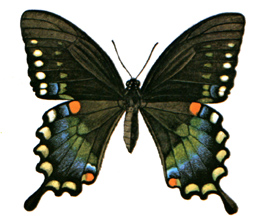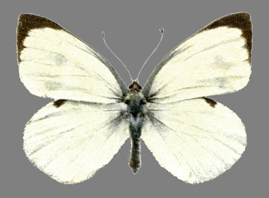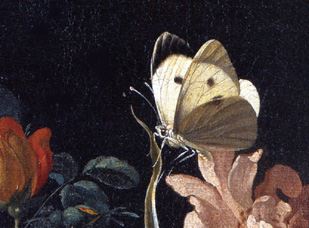Butterflies and Moths in Nabokov's Published Writings
Alphabetical Order ‒ Page 7
... O ... * Pa-Pi * ... Pl ...
Pachythone barcanti [Lycaenidae, Riodininae]: a Trinidad butterfly figured in Malcolm Barcant's Butterflies of Trinidad and Tobago (London [Collins] 1971) which the author had described as a new species and Nabokov recognized as having been described before, by G.E. Tite.
*SelLet 481
Painted Lady: »Vanessa cardui
Palaeochrysophanus (ex Chrysophanus, Lycaena) hippothoe Linnaeus, 1761 [Lycaenidae, Lycaeninae]: a copper on moist meadows from N Spain through most of Europe and E across Siberia to the Amur region and Japan. In Britain it is extinct. The males have a bright violet tinge along the borders of the upper forewings.
*Gift 133
& Ac: Paleochrysóphanus/Chrysóphanus hippóthoë • En: Purple-edged Copper • Fr: le cuivré écarlate, (Autres rivages) le Bronzé • Ge: Kleiner Ampfer(feuer)falter, Dukatenvogel, Lilafalter, Lilagold-Feuerfalter • Ru: червонец шавелевый • Sp: manto de cobre
Pandora: »Pandoriana pandora
Pandoriana (ex Argynnis) pandora Denis & Schiffermüller, 1775 [Nymphalidae, Heliconiinae, Argynnini]: the largest European fritillary (wingspan up to 66 mm), with greenish hindwings above and below. Iberian Peninsula, S France, Italy, Balkans, N Africa and E to C Asia, NW India and W China.
*LHarl 34–35
& Ac: Argýnnis/Pandoriána pandóra • En: Cardinal • Fr: le cardinal • Ge: Pandorafalter, Roter Perlmutterfalter, Grüner Silberstrich • Ru: перламутровка пандора, кардинал • Sp: pandora
Paphia Fritillary: »Argynnis paphia
Papilio Linnaeus, 1758: a genus of »Papilionidae, subfamily Papilioninae (swallowtails). The type-species, selected by Latreille in 1810, is »Papilio machaon, the Swallowtail of Europe. Originally Linné placed all the butterflies of his System in only one genus, Papilio. (Of course, papilio is Latin for 'butterfly'.) Thus Papilio was the very first genus of Rhopalocera. Today, Papilio is a relative small genus, with only four members in Europe and ten in N America.
*NabBut 147 (L), 717 (L); LtVé 159
Papilio alexanor Esper, 1799 [Papilionidae]: the Southern Swallowtail, in isolated populations in SE France, S Balkans, Turkey, Near East, Middle East, Transcaucasia to Iran and C Asia; extinct in Italy.
*NabBut 578 (BE); LtVé 163
Papilio bunnyi: 'Bunny's Swallowtail,' an imaginary butterfly drawn by Nabokov in a letter to Edmund Wilson (Jan 3, 1944).
*N/WLet #85=72old
Papilio dardanus (Internet)

Papilio dardanus Brown, 1776 [Papilionidae]: This African species of swallowtails is the best-known and most spectacular case of Batesian mimicry in butterflies. The males (tailed and predominantly pale yellow with black wingtips and spots) are non-mimetic. The females are highly polymorphic. In some regions (Madagascar, Ethiopia) they mimic the males, while in others they mimic various noxious butterflies in the genera Amauris Hübner, 1816 and Danaus Kluk 1802. Not just six but more than thirty morphs have been described, most of them mimetic.
*Gift 111
& Ac: Papílio dardánus • En: Mocker Swallowtail, Flying Handkerchief • Fr: le voilier faux-monarque • Ge: Afrikanischer Schwalbenschwanz • It: dardano • Ru: (Dar) африканский кавалер
Papilio elwesi (Internet)

Papilio elwesi Leech, 1892 [Papilionidae]: a very rare swallowtail in C China and Taiwan, "a black wonder with tails in the shape of hooves". The wingspan is c. 95 mm; because of the broad, hoove-like tails, the hindwings are as wide as the forewings. The basic color is black and brown; the crescents along the margins of the hindwings are strongly developed and cinnebar.
*Gift 122
& Ac: Papílio élwesi • En: Elwes' Swallowtail • Ge: *Elwes' Schwalbenschwanz • Ru: (Dar) кавалера Эльвеза
Papilio (ex Pterourus) glaucus Linnaeus, 1758 [Papilionidae]: the Tiger Swallowtail, a large and conspicuous swallowtail (wingspan 80–140 mm) common all over N America, especially in the East.
*SelLet 368: NabBut 398 (L)
Papilio hospiton (Hofmann 1894)

Papilio hospiton Guenée, 1839 [Papilionidae]: patterned similar to the European Swallowtail (»Papilio machaon), it is smaller and has only rudimentary tails. It occurs only in Corsica and Sardinia.
*Stor:Aur 250; StrOps 334; NabBut 218 (FB), 578 (BE), 596 (BE)
& Ac: Papílio hóspiton • En: Corsican Swallowtail • Fr: le porte-queue corse • Ge: *Korsischer Schwalbenschwanz • Ru: корсиканский ласточкин хвост, (DarII) госпитон
Papilio indra Reakirt, 1866 [Papilionidae]: the Indra (or Short-tailed Black) Swallowtail, a rather small American swallowtail (wingspan 62–72 mm), black with cream-colored spots, blue patches and orange eyespots, in the Rocky Mountains.
In the index of Pale Fire, there are "Nitra and Indra, twin islands of Blawick". They are two of Nabokov's cryptic butterflies, hidden in a name. »Papilio zelicaon nitra is another black swallowtail in the W of N America. Nitra and Indra are twin islands just as Papilio indra and Papilio zelicaon nitra (or »Erebia disa and »Erebia embla) are twin species.
The larger Grand Canyon subspecies mentioned in Nabokov's letter to William H. Howe (Jan 25, 1965) is Papilio indra kaibabensis Bauer, 1955, the Grand Canyon Swallowtail. (For 'kaibabensis,' cf. »Aricia icarioides.)
*SelLet 369
|
The model: Alcides agathyrsus (Sbordoni 1984) |
The mimic: Papilio laglaizei (Wikipedia) |
|
|
|
*Papilio laglaizei Depuiset, 1877 [Papilionidae, Papilioninae]: In The Gift, there is "a tropical geometrid colored in perfect imitation of a species of butterfly infinitely removed from it in nature's system, the illusion of the orange abdomen possessed by one being humorously reproduced in the other by the orange-colored inner margins of the secondaries".
Karges (1985) identified it as Aletis libyssa, mimicking Danaus chrysippus. It is true that Aletis libyssa (actually Cartaletis libyssa Hopffer, 1857, the type-species of the genus Cartaletis Warren, 1894), the African Monarch Looper, mimics the poisonous African Monarch, called the Plain Tiger in America (»Danaus chrysippus Linnaeus, 1758, Nymphalidae, Danainae). This, however, cannot be the insect referred to. The African Monarch, and hence the Monarch Looper, both have pale yellowish wings with broad black margins. The body, including the abdomen, is black and not orange; and the Looper's hindwings do not in any way mimic the Monarch's abdomen.
However, there is the well-known case of a papilionid butterfly mimicking a poisonous day-flying uraniid moth on the island of New Guinea. The butterfly mimic is Papilio laglaizei Depuiset, 1877 [Papilionidae], the moth model is Alcides agathyrsus Kirsch, 1877 [Uraniidae]. Nabokov may have found it in a book on mimicry by Arnold Jacobi (Mimikry, Braunschweig 1913, p. 155). Jacobi described the case thus: "Both are a dull steel-blue with a faint silvery lustre, have a narrow light badge in the apex of the forewing and a whitish green band across both wings; the hindwings have a narrow silvery white margin. On the underside they are a little more different, but even there one detail makes the butterfly similar to the model, the yellow flanks of the moth's abdomen being imitated by an oblong orange patch along the inner margins of the butterfly's hindwings, of course only when it is resting." That is, the butterfly's wings at rest mimic the moth's brilliantly colored abdomen.
This no doubt is the case Nabokov had in mind. However, he got it slightly wrong in his memory, the geometrid being a uraniid and not the moth but the butterfly being the mimic.
*Gift 110–111
Papilio machaon (Lampert 1907)
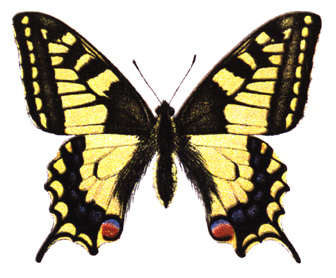
Papilio machaon Linnaeus, 1758 [Papilionidae]: the (Old World) Swallowtail, a stately butterfly of the Northern hemisphere, the cover beauty of many a butterfly book. Papilio was Linné's first and only genus of butterflies, and machaon was (and is) its type-species – so in a way it is the first of all butterflies of science.
The Swallowtail has a wingspan of 50–75 mm. The color is yellow and black, with blue lozenges and a red eyespot on the hindwings. It is a rather variable species; many forms and aberrations have been described. Its range is from N Africa across Europe (except for Britain) and temperate Asia N of the Himalayas to Japan; there are several subspecies in N America.
According to Speak, Memory, it was a Swallowtail that set Nabokov's lifelong passion for butterflies in motion in June 1906 on the Vyra estate: "… my guiding angel […] pointed out to me a rare visitor, a splendid, pale-yellow creature with black blotches, blue crenels, and a cinnebar eyespot above each chrome-rimmed black tail. As it probed the inclined flower from which it hung, its powdery body slightly bent, it kept restlessly jerking its great wings, and my desire for it was one of the most intense I have ever experienced" (p. 120).
In an interview with Gerald Clarke for Esquire (1975), Nabokov mentioned that as a boy he had dreamed of one day writing a monograph on "the Eurasian and American machaon group."
In the copy of King Queen Knave Nabokov dedicated to his Berlin entomologist friend Nikolai »Kardakoff (in the collection of Terry Myers of San Jose, CA), Nabokov wrote parts of a Russian poem on the Swallowtail:
... From afar you can discern the swallowtail
from its sunny, tropic beauty:
along a grassy slope it dashes
and settles on a roadside dandelion.
My net swings, the muslin loudly rustles.
O, yellow demon, how you quiver!
I am afraid to tear its dentate little fringes
and its black, supremely slender tails.
Also, on occasion in the oriole-filled park,
some lucky mid-day, hot and windy,
I'd stand, ecstatic at the fragrance, before a tall and fluffy lilac,
almost crimson in comparison
with the deep blue of the sky,
and, dangling from a cluster, palpitating,
the swallowtail, a gold-winged guest, grew tipsy,
while, blindingly, the wind was swaying
both butterfly and luscious cluster.
You aim, but the branches interfere;
you swing – but with a flash it vanishes,
and from the net turned inside out
tumble only severed crests of flowers.
(Translation from the Russian by Dmitri Nabokov)
*Stor:Xmas 134; Glory 9; Gift 133; SpeakM 120, 122; Ada 393; StrOps 332; SelLet 113, 287; NabBut 121 (P), 147 (L), 527 (L); Lep2 257, 268
& Ac: Papílio macháon • En: (European) Swallowtail, Machaon Swallowtail, Old World Swallowtail, Artemisia Swallowtail • Fr: le machaon, le porte-queue • Ge: Schwalbenschwanz • It: macaone • Ru: (парусник) Махаон • Sp: macaón
Papilio machaon alpica Verity, 1911 [Papilionidae]: allegedly a subspecies of the Old World Swallowtail, "up to 2000m in the Maritime Alps," Nabokov thought it an "altitudinal form hardly worth naming". The name alpica has been synonymized under machaon, leading to its demise.
*NabBut 582 (BE)
Probably Papilio machaon britannicus, as figured by Moses Harris in The Aurelian (1766)

Papilio machaon britannicus Seitz, 1906 [Papilionidae]: the Norfolk Swallowtail, the English subspecies of »Papilio machaon, the Old World Swallowtail. It is narrower and darker than the Swallowtail on the Continent. The black outer margins of the wings are broader, the veins are more clearly outlined in black. Formerly found in all of England, it had retreated to the fens of Cambridgeshire and Norfolk (the Norfolk Broads) but since 1952 was said to be extinct. There have been attempts to boost its numbers by captive breeding. In Ada, the patrons of a Norfolk Broads "floramor" have nicknamed a model 'Swallowtail'.
*Ada 393; StrOps 332; SelLet 474; NabBut 578 (BE)
Papilio machaon gorganus Fruhstorfer, 1922 [Papilionidae]: one of many subspecies of the Old World Swallowtail, in SW Europe, Urals and Caucasus.
*NabBut 578 (BE)
Papilio machaon machaon Linnaeus, 1758 [Papilionidae]: the nominate subspecies of the Old World Swallowtail, that is, the specimen originally described by Linné from Sweden tautonymically designated as the first of its subspecies.
*NabBut 572 (BE), 573 (BE), 578 (BE)
Papilio machaon sphyrus Hübner, 1823 [Papilionidae]: Nabokov considered this a valid subspecies of the Old World Swallowtail: "… as figured by Verity from S. Italy (type locality probably Sicily) goes from dark, heavy, richly colored specimens from Palermo (which he says cannot be distinguished from machaon britannicus Seitz) to very light, slender, pale ones (from Sardinia but I have taken such specimens also in Cannes, in August)." Today sphyrus is treated as a synonym of machaon.
*NabBut 571 (BE)
Papilio podalirius: »Iphiclides podalirius
|
Papilio troilus (Howe 1975) |
Caterpillar of Papilio troilus (from Blogspot »Razzberry Corner, Maryland) |
|
|
|
Papilio troilus Linnaeus, 1758 [Papilionidae]: the Spicebush Swallowtail, in the E United States. Its caterpillar has two large eyespots between head and thorax that give it a decidedly snakelike look. If threatened, the false head pops out of the body, swelling and even thrashing to and fro in snake fashion. It is obviously counting on the fact that birds and other predators will not reflect on the smallness of this pseudo-snake.
*possibly Gift 110
Papilio waterclosetensis: the imaginary "watercloset parnassian or swallowtail" drawn by Nabokov in a bathroom of his friend Morris Bishop's Ithaca home.
*SelLet 400
Papilio zelicaon nitra W.H. Edwards, 1883 [Papilionidae]: the Nitra (or Gothic) Swallowtail, an uncommon black subspecies of the Anise Swallowtail, along the E slopes of the Rocky Mountains from Alberta to Colorado.
In the index of Pale Fire, there are "Nitra and Indra, twin islands of Blawick". »Papilio indra is another black swallowtail in the W of N America. Nitra and Indra are twin islands just as Papilio indra and Papilio zelicaon nitra and »Erebia disa and »Erebia embla are twin species.
In his interview with Robert H. Boyle, Nabokov recalled "a marvelous day in Alberta when he found 'a treasure, a nitra Swallowtail, sitting there on bear dung'."
*PaleF 311, Int1 130 (NabBut 535)
Papilionidae Latreille, 1802: a small family of large to very large butterflies, some of them very stately and strikingly patterned, comprising around 630 species, most of them flying in the tropics. Their name derives from the Latin word for butterfly, papilio. There are three subfamilies. The largest one is that of Papilioninae, or swallowtails, with some 550 species, most of them in the tropical regions of the Old World. They are rather large, mostly very colorful, and usually have a horn or tail on each hindwing. The smaller group, with 54–76 known species, most of them Palearctic, is that of the Parnassiinae, or apollos. They have no tails, their wings are whitish, diaphanous and rounded, with a few dark eyespots; the bodies are thickly covered with dark hair, and the flight is slow and ambling. The third subfamily, Baroniinae, consists of one sole species, »Baronia brevicornis.
& Ac: Papiliónidae • En: papilionids (apollos and swallowtails) • Fr: papilionidés • Ge: Papilioniden, Ritter(falter), Segelfalter (Apollos, Schwalbenschwänze, Vogelflügler) • It: papilionidi • Ru: парусники, кавалеры • Sp: papiliónidos
Parachilades Nabokov, 1945: a new genus of S American blues named by Nabokov. See in »Section 1.
*Lep9 7–11, 47, passim
Paradisia radugaleta: "the rainbow-colored butterfly of paradise," a wholly imaginary butterfly Nabokov drew for his wife on January 1, 1969.
*Véra's Butterflies, p. 44
Paralycaeides Nabokov, 1945 [Lycaenidae]: a new genus of »Lycaenidae named by Nabokov (subfamily Polyommatinae [blues], tribe Polyommatini, Polyommatus Section). See in »Section 1.
*Lep9 36–38, 47; Lep14 480
Paralycaeides (ex Itylos) inconspicua Draudt, 1921 [Lycaenidae]: a rare polyommatine of the vapa species-group, from the High Andes of C and S Peru (Cuzco). There are only three specimens preserved in museum collections.
*Lep9 36–38
Pararge Hübner, 1819: a genus of »Nymphalidae, subfamily Satyrinae, tribe Parargini (GB browns). The type-species is »Pararge aegeria, the Speckled Wood.
*NabBut 593 (BE)
Pararge aegeria (Sepp 1762)
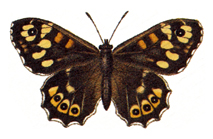
Pararge aegeria Linnaeus, 1758 [Nymphalidae, Satyrinae]: a satyrine with a wingspan of 32–42 mm, flying in deciduous woodlands from N Africa across Europe to Urals. It forms distinct geographical races. The C European one is the subspecies tircis Butler, 1867; its wings are light brown with cream-colored spots.
"The southern subspecies is especially at home in sun-speckled groves but also occurs in the open, along low hedges etc. The northern subspecies, on the other hand, is with »Lopinga achine one of the very few exclusively woodland butterflies of Europe."
In May 1908 Nabokov's father, then serving a three months term in St. Petersburg's Kresty prison for a political offense, inquired by letter whether his son had gotten "any Egerias" that summer. So the Speckled Wood, though common, seems to have been a coveted species at the beginning of Nabokov's passion for butterflies.
*SpeakM 147, 176; NabBut 98; Lep2 255, 269
& Ac: Parárge aegéria • En: Speckled Wood, (Nabokov) Egeria • Fr: le tircis • Ge: Waldbrettspiel, Laubfalter • Ru: (краеглазка) эгерия • Sp: mariposa de los muros, maculada
Pararge aegeria var. intermedia Weismann, 1875 [Nymphalidae, Satyrinae]: a variety of the Speckled Wood described from the French Riviera. The variety has not been promoted to subspecific rank and thus has no taxonomic standing.
*Lep1 32
Pararge maera: »Lasiommata maera
Pararge megera: »Lasiommata megera
Pararge roxelana: »Kirinia roxelana
Pargus centaureae freija: correctly »Pyrgus centaureae freija
Parnassius Latreille, 1804: a very distinct genus of »Papilionidae, subfamily Parnassiinae (apollos or parnassians). The type-species is »Parnassius apollo. There are about seventy-five species of Parnassiinae, flying mostly in the colder and mountainous regions of the northern hemisphere. Their true realm are the high mountains of C Asia where they fly at altitudes between 3,000 and 4,800 m. The Common Red Apollo (Parnassius epaphus sikkimensis Elwes, 1882) in the main Himalayan range between Chitral and Sikkim, flying up to 5,000 m sideways against the strong cold winds during the short hours of sunshine, may be the altitude champion among butterflies. As they typically live in remote and inaccessible valleys with little or no interbreeding, a great number of local subspecies have evolved. They are difficult to research, very little is known about their life history, and many may not yet be known to man.
In Europe there are just three –
◦ Parnassius apollo Linnaeus, 1758
◦ Parnassius phoebus Fabricius, 1793
◦ Driopa mnemosyne Linnaeus, 1758
In N America likewise –
◦ Parnassius eversmanni Ménétriès, 1849
◦ Parnassius clodius Ménétriès, 1855
◦ Parnassius phoebus Fabricius, 1793
Thus phoebus is Holarctic
The apollos are medium-sized, have stout bodies, almost transparent pale white or pale yellow wings turning gray in some, with dark markings and sometimes one or two bright red spots on the hindwings which are incurved. As flyers, they are rather slow and "lazy". In Speak, Memory (p. 210) there is this description: "… strange butterflies of ancient lineage, with rustling, glazed, semitransparent wings and catkin-like flossy abdomens." After mating, the males glue a waxy pouch called a sphragis on the tip of the abdomen of the female, preventing further couplings. All three European species are endangered and in many countries protected by law.
In The Gift (p. 117–118), Fyodor's father on one of his expeditions to C Asia collects "some royal relative of our Apollos," a "white, richly ocellated butterfly", "its hairy yellowish incurved body resembling a willow catkin, and the glazy underside of its crisp folded wings showing the blood-red maculation at their roots". This of course is an invented butterfly (and not necessarily the Imperatorial Apollo of The Gift, p. 123). Nevertheless, its description fits several really existing ones of the charltonius group (named after Parnassius charltonius Gray, 1852, from the SE Himalayas) of C Asia and the Himalayas; several of these have "royal" names, for instance Parnassius charltonius autocrator Avinoff, 1913 and »Parnassius imperator Oberthür, 1883.
In the Russian poem "Slava" ("Fame"), 1942, Nabokov thinks back to his Russian childhood:
It is far to the meadows where I sobbed in my childhood
having missed an Apollo …
In Ada there is a "strange pale butterfly" at the beginning of a picnic in Ardis (p. 79), a "pale diaphanous butterfly with a very black body … closely related to a Japanese Parnassian" following them after the picnic (p. 85) and a "transparent white butterfly floating by" before Van's duel with Captain Tapper (p. 310). It is likely they all are the same butterfly, some imaginary parnassian. The Japanese parnassian referred to could be any of the Japanese subspecies of Parnassius stubbendorfi Ménétriès, 1849; they are all quite similar to the Black Apollo of Europe: glacialis Butler, 1866 (sometimes treated as a species of its own), hokkaidensis Bryk & Eisner, 1914, geisha Bryk & Eisner, 1932, mikado Bryk & Eisner, 1932 and nagoensis Bryk & Eisner, 1932. Perhaps the blackest of them is geisha, restricted to the province of Shinano.
*Ada 79, 85, 310; Stor:Aur 250; Gift 112, 117–8; P&P 105; Ada 85; StrOps 90; NabBut 201 (FB), 250 (P), 309; LtVé 249
& Fr: parnassien, apollon • Fr: apollons • Ge: Alpenfalter, Apollofalter, Parnassier • Ru: (Dar, DarII) Аполлон
Parnassius apollo (Lampert 1907)

Parnassius apollo Linnaeus, 1758 [Papilionidae]: the largest of the three European representatives of the genus »Parnassius (wingspan 70–74 mm), in the larger mountain areas of Europe E to Tianshan and W Siberia.
There is "large white butterfly" with "papery wings, blotched with black and maculated with faded crimson" in Transparent Things. The "papery wings" make it clear that it must be one of the three European parnassians. It cannot be »Driopa mnemosyne as it has some "faded crimson" which the Clouded Apollo lacks, being all black-and-white. So it must be either apollo or phoebus. Both are quite similar, and both occur in the Swiss Alps at middle altitude. The "large" size makes apollo more likely – phoebus is the smaller one. During his years in Montreux Nabokov took both of them, but he did not capture phoebus in the German speaking parts of Switzerland where the novel is mostly set. One of Nabokov's apollos was taken on August 9, 1971 at Saanen-Belmont, in the mountains N of Montreux, just when he was writing Transparent Things. All this makes apollo the more likely candidate.
In his notes for "The Butterflies of Europe", Nabokov says about Parnassius apollo, "One of the most popular European butterflies equally at home in Scandinavia and Sicily with a wide palearctic range from the mountains of Spain, Portugal and France to the plains and mountains of N. and Cen. Asia, from N. Norway to Sicily and Armenia. It is not found either in England or N. Africa and does not reach the Pacific (as phoebus does). Hundreds of 'subspecies' have been described, most of which have no taxonomic or biological standing whatever … One of the most comic escapades in the apollo nomenclatorial farce is a batch of eight 'subspecies' all from Tyrol (!) named by a Herr H. Belling of Berlin-Pankow and carefully preserved in his collection (they all sink with a number of others to brittingeri … (besides about ten other 'subspecies' named from the Tyrol making of that small but touristically very accessible region a perfect paradise for race-names)". In its turn, brittingeri is an 'aberration' of apollo described by Rebel & Rogenhofer from the E Alps and has no taxonomic standing either.
*TranspTh 90; NabBut 583–4 (BE); Lep1 30; LtVé 133, 151, 193
& Ac: Parnássius apóllo • En: Apollo, Alpine Butterfly • Fr: l'apollon • Ge: Apollo(falter) • It: apollo • Ru: парусник Аполлон • Sp: apolo
Parnassius apollo provincialis Kheil, 1905 [Papilionidae]: a subspecies of The Apollo described from Provence, France. "Bryk (1935) darkly points out that the types were bred by Kheil in Prag, but a true subspecies does not change pour si peu unless subjected to experimental temperatures when, however, the resulting aberration should still retain the ssp. basis …"
*NabBut 584 (BE)
Parnassius eversmanni Ménétriès, 1850 [Papilionidae]: a parnassian of E Russia, Mongolia, Japan and Alaska. The wingspan is 48–57 mm. The males are yellow, the females pale yellow or white. On the hindwing, the males have two crimson spots and the females three red spots.
*NabBut 206 (FB)
& Ac: Parnássius éversmanni • Am: Eversmann's Parnassian • Ru: (DarII) Эверсмана Аполлон
Parnassius imperator (Romanoff 1884-1901)
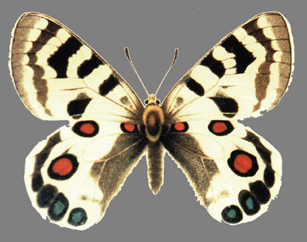
Parnassius imperator Oberthür, 1883 [Papilionidae]: an impressive parnassian [»Parnassius] of Tibet and SW China. Fyodor's father collected its caterpillar near Tatsienlu: "There on the slopes of a snowy range, which were drowned in the rich, rosy foam of great rhododendrons (we used their branches at night for our campfires), I looked in May for the slate-gray, orange-spotted larvae of the Imperatorial Apollo and for its chrysalis, fastened by means of a silk thread to the underside of a stone." This is exactly where the British naturalist A.E. »Pratt whose travel account Nabokov was well acquainted with had collected it in May 1890: "I found time to search for the larvæ of Parnassius imperator and got about twenty, and one pupa. The larva is found on a species of umbelliferous plant and is of a dark slate colour, with ten orange spots on each side, each spot with a black rim. It is covered with short grey hairs, and when touched curls itself into a ring. Its length is 1 3/8 inch. The pupa is brown, and is found attached by a silk web to the under surface of stones" (To the Snows of Tibet through China, London 1892, p. 183).
From one of Nabokov's other sources (Grum-Grzhimaylo 1899, p.361, 367, 375) it is clear that the "royal relative of our Apollos, which had been skimming with a ranging flight over the dangerous screes" in the province of Gansu, China, was Parnassius imperator musagetus Grum-Grzhimaylo.
*Gift 117, 123
& Ac: Parnássius imperátor • En: (Nabokov) Imperatorial Apollo • Fr: (Don) l'apollon impérial • Ge: *Imperatorapollo
Parnassius mnemosyne: »Driopa mnemosyne
Parnassius phoebus Fabricius, 1793 [Papilionidae]: a Holarctic parnassian [»Parnassius] much like »Parnassius apollo Linnaeus, 1758 but smaller (wingspan up to 60 mm instead of 75 mm). Its range is the Urals and the Siberian tundra; in N America it occurs from subarctic Alaska down the Rocky Mountains to New Mexico; in C Europe it is found only at higher altitudes in the Alps.
*Gift 103
& Ac: Parnássius phoébus • Am: Phoebus Parnassian • En: Small Apollo • Fr: le petit-apollon • Ge: (Hoch-)Alpenapollo • It: febo, apollo delli Alpi • Ru: парусник Феб, альпийский Аполлон • Sp: apolo pequeño
Parnassius phoebus cervinicolus Fruhstorfer, 1907 [Papilionidae]: an alleged subspecies of the Phoebus Parnassian named after Mt. Cervin where its author supposedly found it, as did Nabokov: "I have found it common in July, 1961, along the western bank of Visp R, just N of Zermatt at 1650m." Parnassius phoebus cervinicolus is no valid subspecies and has been synonymized under phoebus.
*NabBut 584 (BE)
Parnassius phoebus golovinus Holland, 1930 [Papilionidae]: a subspecies of the Small Parnassius or Phoebus Parnassian, in W Alaska. Though Nabokov wrote that golovinus, named after Vice Admiral V.M. Golovnin, rates "a big sic," Karges (1985) says the correct form is golovninus. That's perhaps what the American lepidopterist William Jacob »Holland should have called it, but he certainly did not, writing "Parnassius delius Esper, var. golovinus Holland" – no 'n'. According to the Code, names may not be emended.
*SpeakM 52
& Ac: Parnássius phóebus golovínus • En: *Golovnin's Phoebus Parnassian • Ge: *Golownins Alpenapollo
Parnassius phoebus sayii W.H. Edwards, 1863, syn f. hermodur Henry Edwards, 1881 [Papilionidae]: Say's Parnassian, a subspecies of the Phoebus Parnassian from the mountains of Colorado, South Dakota, Nevada, Wyoming and New Mexico. Edward's "f. hermodur" is a synonym not of sayii but of rubina Wyatt 1961 which in turn is a synonym of sayii.
*NabBut 501 (L)
Parnassius phoebus smintheus Doubleday, 1847 [Papilionidae]: the Smintheus (Parnassian), in the Canadian Rocky Mountains of Alberta and British Columbia. This is the first parnassian described from N America, probably collected by Lord Derby near Banff or Lake Louise.
*NabBut 501 (L)
Peacock Butterfly: »Inachis io
Peacock Moth: »Saturnia pyri
Pear Peacock: »Saturnia pyri
Persian Vaporer: »Vaporer
Phaedrotes Scudder, 1876: an abandoned genus of »Lycaenidae, subfamily Polyommatinae (blues). The type-species was »Glaucopsyche piasus Boisduval, 1852.
*NabBut 445
'Phaedrotes' piasus: »Glaucopsyche piasus
Phalen: As Nabokov explained in a letter to Alfred Appel, Jr., "Miss Phalen's name attracted me because phalène means moth in French". Linnaeus originally listed all butterflies in one genus only, Papilio, and all (predominantly night-flying) moths in another one, Phalaena.
*Lol 56; SelLet 410, 413
Philotes Scudder, 1876: a genus of »Lycaenidae, subfamily Polyommatinae (blues), tribe Polyommatini, Glaucopsyche Section. The type-species is Philotes regia Boisduval, 1869. *NabBut 445
Philotes baton albonotata: »Pseudophilotes baton var. albonotata
Philotes bavius fatma Oberthür, 1890 [Lycaenidae]: a blue, very locally in Morocco and Algeria.
*StrOps 334
& Ac: Philótes bávius fátma • En: Fatma Blue • Ge: *Fatma-Bläuling
Philotes enoptes: »Euphilotes enoptes
Phoebis argante Fabricius, 1775 [Pieridae, Coliadinae]: the Argante Giant Sulphur, in Texas, C America, Cuba, S America.
*SelLet 103
Phoebis sennae eubule (Encyclopedia of Butterflies 1993)

Phoebis sennae eubule Linnaeus, 1767 [Pieridae, Coliadinae]: a subspecies of Phoebis sennae Linnaeus, 1758, the Cloudless Sulphur, ranging through the Americas, from New England to Patagonia. Like another American Sulphur, »Eurema lisa, it migrates in large swarms.
*StrOps 328, LtVé 465
Phorcis Hübner, 1819 (not Phorcys): an abandoned genus of »Nymphalidae, subfamily Satyrinae, tribe Erebiini (US alpines, GB ringlets and arguses). The type-species was »Erebia epistygne, the Spring Ringlet.
*NabBut 590–2 (BE)
Phyciodes Hübner, 1819: an all-American genus of »Nymphalidae, subfamily Nymphalinae, tribe Melitaeini (crescentspots). The type-species is »Phyciodes tharos, the Pearl Crescent.
*NabBut 408 (L)
Phyciodes batesii Reakirt, 1865 [Nymphalidae]: the Tawny Crescent, from New England, Quebec and Ontario to Nebraska and Virginia.
*NabBut 408 (L)
Phyciodes mylitta W.H. Edwards, 1861 [Nymphalidae]: the Mylitta Crescent, from SW Canada to S Mexico.
*NabBut 408 (L)
Phyciodes mylitta barnesi: probably a misprint for »Phyciodes pallida barnesi.
*StrOps 326
Phyciodes orseis W.H. Edwards, 1871 [Nymphalidae]: the Orseis Crescent, from San Francisco Bay to SW Oregon and Canadian Sierra Nevada.
*NabBut 408 (L)
Phyciodes pallida barnesi Skinner, 1897 [Nymphalidae]: the Thistle Crescent, from British Columbia and NW United States to Montana, Utah and E Nevada.
*NabBut 408 (L)
Phyciodes phaon W.H. Edwards, 1864 [Nymphalidae]: the Phaon Crescent, from S Virginia to Kansas and S California and southward to Honduras.
*NabBut 408 (L)
Phyciodes pictus W.H. Edwards, 1865 [Nymphalidae]: the Painted Crescent, from W Nebraska to SC Arizona and N Mexico.
*NabBut 408 (L)
Phyciodes tharos Drury, 1773, syn cocyta Cramer, 1777 [Nymphalidae]: the Pearl Crescent, from C Canada to S Mexico and from the Atlantic to the Pacific Coast.
*NabBut 398 (L), 408 (L)
Phyciodes vesta W.H. Edwards, 1869 [Nymphalidae]: the Vesta Crescent, from Texas to Guatemala.
*NabBut 408 (L)
Phyllodesma (ex Epicnaptera) japonica arborea Blöcker, 1908 [Lasiocampidae, Gastropachinae]: a small lappet moth with hoary wings, a "little furry monster," "plump," "reddish-gray," "with sinuate margins, of the leaf-mimicking kind, hanging asleep from a stalk under a bush," in Japan, Siberia, Russia and the Baltic states. Nabokov used the generic name Epicnaptera Rambur, 1866 which was a junior synonym of Phyllodesma Hübner, 1820. The type-species of the genus is Phyllodesma suberifolium Duponchel, 1842. The members of the genus when resting mimic a dead leaf; for this reason they are rarely seen.
Fyodor's father thought he had brought back the first specimen of this moth from his travels to C Asia, but then he found it himself in the Province of St. Petersburg, and a few days later "learned that this new moth had just been described from St. Petersburg specimens by a fellow scientist, and Fyodor cried all night long: they had beaten Father to it!". This fellow scientist must have been Hermann »Blöcker. His OD was published in 1908 (G. Bleker: "Novyi evropeiskii shelkopyad, Epicnaptera arborea, n.sp. (Lepidoptera, Lasiocampidae)", Revue Russe d'Entomologie, 2, 1908, p. 126–132, in Russian and German).
*Gift 95
& Ac: Phyllodésma/Epicnáptera japónica arbórea • En: (Nabokov) Epicnaptera moth • Ge: Japanische Glucke
pierid: any member of the family »Pieridae. Often pierids are rashly equated with 'whites'. The problem with the term 'white' is the same as with »blues or »coppers: color and scientific classification are not in agreement. Many pierids are not white at all, and there are many butterflies outside the Pieridae that are more or less white.
In The Gift (p. 111), there is mention of pierids that move through the sky in "white clouds, indifferent to the direction of the wind". Several pierid species are strongly migratory. Two that migrate in swarms of millions are Belenois aurota Fabricius 1793 in tropical Africa, Arabia, Pakistan, Afghanistan, Beluchistan and India and Belenois java teutonia Fabricius, 1775 in Australia.
In "Father's Butterflies" (p. 206) there are "the orange wingtips, almost in keeping with fashion, of the African pierids". These could be the Moroccan Orange-tip (Anthocharis belia Linnaeus, 1767), the Sooty Orange-tip (Zegris eupheme Esper, 1805) and the Desert Orange-tip (Colotis evagore Klug, 1829).
*KQK 260; Gift 111, 119; StrOps 328; SelLet 410; NabBut 206 (FB)
& Ac: Belenóis auróta • En: Brown-veined White, Pioneer
& Ac: Belenóis jáva teutónia • En: Caper White
Pieridae Duponchel, 1832: a family of butterflies, usually but not always white or yellow and of medium size, comprising about 1,100 species in 76 genera all over the world, 60 in N America and 49 in Europe. The antennae are short and straight. The wing-beat frequence is low, their flight is rather slow but highly erratic (hard to catch for a bird), but many of them are strong migrants. Their name derives from a surname of the nine muses of Greek mythology, Pierides.
In Europe and America, there are three subfamilies: the Pierinae (whites), the Coliadinae (sulphurs or yellows) and the Dismorphiinae. The Anthocharinae (Marbles and Orange-tips) which used to form a subfamily of their own have been subsumed under Pierinae.
*NabBut 268 (L); LtVé 465, 475
& Ac: Piéridae • En: pierids, yellow-white butterflies (whites, yellows or sulphurs, orange-tips) • Fr: piéridés (piérides, aurores, coliades, citrons) • Ge: Pieriden (Weißlinge, Gelblinge, Aurorafalter) • It: pieridi • Ru: белянки, (DarII) пьернды • Sp: piéridos
Pieris Schrank, 1801: a genus of usually white »Pieridae, subfamily Pierinae (whites), with »Pieris brassicae Linnaeus, 1758 (the Large Cabbage White) as type-species.
*NabBut 270 (L); LtVé 475
|
Pieris brassicae (Lampert 1907) |
A female of the Cabbage White (Pieris brassicae?) in a flower still life by Rachel Ruysch (1664-1750). See also »Butterflies in Art. |
|
|
|
Pieris brassicae Linnaeus, 1758 [Pieridae]: the larger one of the two common white cabbage butterflies, "rarer in Western Europe now than a century ago when it was considered the commonest European butterfly. Well known for its migratory properties … Ranges from N. Africa and the Azores to N. Scandinavia, E. Siberia and N. India." The wingspan is 50–65 mm. It has no clear habitat preferences as long as there are cruciferae as foodplants for its caterpillar, especially brassica, cabbage (white cabbage, savoy cabbage and turnip cabbage), and thistles and knapweeds as foodplants for the butterfly. Lat. brassica is 'cabbage'.
The nominal subspecies Pieris brassicae brassicae is from Sweden. The species brassicae, says Nabokov, "has a curious propensity of developing striking insular races, Canaries, Madeira, Azores, Cyprus …"
It still seems unclear whether the 'race' occurring on the Azores (Pieris brassicae azorensis Rebel, 1917) and the possibly extinct Madeira race (Pieris brassicae wollastoni Butler, 1886) are good subspecies or just local forms of the nominate subspecies Pieris brassicae brassicae. The same is true of the two Cyprus 'races' (Pieris brassicae cypria Verity, 1908 and Pieris brassicae catoleuca Rebel, 1939).
*Mary 91; Gift 108, 133; Stor:Aur 250; SpeakM 127, 176; PaleF 184; Ada 128; StrOps 329; LHarl 35; SelLet 284; NabBut 585 (BE); Lep1 32; Lep2 256, 268; LtVé 117
& Ac: Píeris brássicae • En: Large (Cabbage) White • Fr: la piéride du chou, (Don) piéride, (Autres rivages) la Grande Piéride • Ge: Großer Kohlweißling • It: cavolaia maggiore • Ru: капустница, белянка капустная • Sp: blanca de la col
The Bryony White, Pieris (napi?) bryoniae, f. (Berge 1899)

Pieris (ex Artogeia) bryoniae Hübner, 1806 [Pieridae]: The males are white and very much like those of »Pieris napi, the Green-veined White; the females have strong dark veins. The wingspan is 35–48 mm. In Europe, it is confined to the Alps and the Carpathians. Its occurrence in the Caucasus region and in the mountains of temperate Asia has been suspected but not definitely confirmed. Many authors have considered the Bryony White a form, or perhaps a subspecies, of the Green-veined White, Pieris napi, some still do so. Tolman & Lewington (1997): "Hybrids with A. napi in areas of distributional overlap are reportedly infrequent: in captivity, cross-pairings result in progeny of poor viability." Which means that bryoniae seems to be a species in the making.
*StrOps 332; NabBut 586 (BE)
& Ac: Píeris/Artogéia bryóniae • En: Mountain Green-veined White • Fr: le courtaud, la piéride de l'arabette • Ge: Bergweißling, *Bryonia-Weißling, *Zaunrüben-Weißling • Ru: белянка горная
'Pieris' callidice occidentalis Reak.: »Pontia occidentalis
Pieris cheiranthi (Lampert 1907)
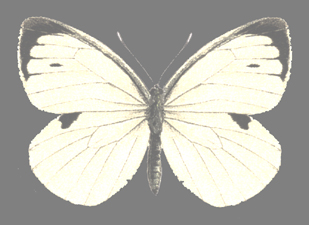
Pieris cheiranthi Hübner, 1806 [Pieridae]: the Large White that Mademoiselle crushes when sitting down on Nabokov's boyhood collection is said to be "an aberration resembling the Canarian race of the species". The Canarian relative of the Large Cabbage White is Pieris cheiranthi Hübner, 1806, formerly considered a subspecies of Pieris brassicae. It is c. 10 mm larger than brassicae; the females have larger, merging black macules on the forewings and yellowish hindwings.
*SpeakM 127
& Ac: Píeris cheiránthi • En: Canary Islands' Large White • Fr: la piéride canarienne • Ge: *Kanarenweißling
Pieris deota de Nicéville, 1883 [Pieridae]: The range of this white is Kashmir, Karakorum, the Pamirs and Himalayas. Pieris roborowskii Alphéraky, 1887 is an invalid synonym of P. deota, named in honor of V.I. »Roborovski (1856–1910), one of Przhevalski's aides on his second expedition to touch Lop-Nor in 1885. Grum-Grzhimailo (1890, p. 404) wrote he had taken a male and a female "sur la route entre le Lob-noor et l'Ak-sou" and that the name had been chosen in memory of Roborovski because to him "est due, presque en entier, la collection entomologique rapportée par l'expédition du general Przevalsky". Nabokov probably made Konstantin Godunov find P. deota on Lop-Nor because it is one of the very few butterflies and the only pierid mentioned in Staudinger's Catalog (1901) as occurring on "Lob-noor". The other localities mentioned there are Ladakh, Pamir, Issyk-Kul.
*Gift 124
& Ac: Píeris deóta/roborówskii • En: (Nabokov) Roborovski's White • Ge: *Roborowskijs Weißling • Ru: (Nabokov) пьерид Роборовского
Pieris ergane (Hofmann 1894)
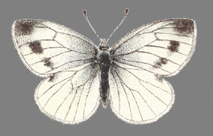
Pieris (ex Artogeia) ergane Geyer, 1828 [Pieridae]: There is a description of this little white (wingspan 36 to 40 mm) in Look at the Harlequins!: "On the upper side … this species shares with its nearest allies – the Small White and Mann's White, both common here – the typical little spots of the forewing, namely a black full stop in the male and a black Doppelpunkt ('colon') in the female. In those allies the punctuation is reproduced on the underside, and only in the species of which you see a folded specimen on the flat of my hand is the wing black beneath – a typographical caprice of Nature! Ergo it is an Ergane". The range is S Europe, especially Balkans, Asia Minor, Iran. Its author (Hübner's assistant who continued the latter's work after his death) considered it just a S European variety of »Pieris rapae, the Small White.
*LHarl 35–36
& Ac: Píeris/Artogéia ergáne • En: Mountain Small White, (Nabokov) Ergane • Fr: la piéride de l'aethionème • Ge: *Ergane-Weißling • Ru: скальная белянка • Sp: blanca escasa
Pieris (ex Artogeia) krueperi Staudinger, 1860 [Pieridae]: a white with a wingspan of 47–49 mm, from S Balkans through Asia Minor, Iran and Afghanistan to N Pakistan and NE India.
*SpeakM 253
& Ac: Píeris/Artogéia krúeperi • En: Krueper's (Small) White • Fr: la piéride de Krueper • Ge: Krüpers Weißling
Detail from Jan van Huysum: "Fruit Basket," probably Pieris mannii

Pieris (ex Artogeia) mannii Mayer, 1851 [Pieridae]: a white similar to the Small White (»Pieris rapae), flying in Morocco, S and SE Europe and Asia Minor. "One of the most interesting Palearctic butterflies. It remained unrecognized and neglected (mainly owing to Staudinger's Catalog [1901] considering it as an insignificant variety of rapae) for fifty-six years after the publication of its description."
*SpeakM 205; StrOps 60; LHarl 35; NabBut 212 (FB), 585 (BE); Lep2 256, 268
& Ac: Píeris/Artogéia mánnii • En: Southern Small White, Mann's White • Fr: la piéride de l'ibéride • Ge: Manns Weißling • Ru: венгерская белянка • Sp: blanca catalana
Pieris napi (Lampert 1907)

Pieris (ex Artogeia) napi Linnaeus, 1758 [Pieridae]: a very common white all over Europe including the Mediterranean islands, N Africa, Asia between 40 and 70ºN, N America. It is found in grassy, damp places with some shade, as along bushy or wooded rivers and creeks. The wingspan is 40–44 mm. The caterpillar prefers watercress (Nasturtium officinale) as a hostplant. Lat. napus is 'rape'.
The subspecies flavescens Müller 1933 seems to be considered a synonym of napi. "One of the many intermediate local forms intergrading variously into bryoniae, which occur at moderate elevation in Austria, North Italy and elsewhere."
*StrOps 60; NabBut 585–6; Lep1 30; Lep2 256, 268
& Ac: Píeris/Artogéia • En: Green-veined White, Mustard White • Fr: la piéride du navet • Ge: Rapsweißling • It: pieride del navone • Ru: белянка бруквенная, бруквенница • Sp: blanca verdinervada
Pieris (ex Artogeia) pseudorapae Verity, 1908 [Pieridae]: a species in the napi-group of whites very close to Pieris rapae and Pieris mannii described in 1908 by the Florence lepidopterist Roger »Verity. Probably it is Verity's voice that, in "Father's Butterflies," remarks in the imaginary shoptalk among European butterfly collectors, "… il existe entre celle de la rave et celle de Mann une espèce méditerranéenne …" The type locality was Beirut, Lebanon. The range of the species is S Europe eastwards to Turkey, the Black Sea, Caucasus and Iran.
*Implied NabBut 212 (FB)
Pieris rapae (Lampert 1907)
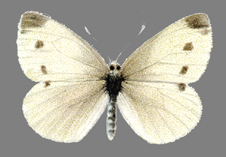
Pieris (ex Artogeia) rapae Linnaeus, 1758 [Pieridae]: a common white in NW Africa, all of Europe, Asia and Japan; it has been introduced to N America and Australia. The wingspan is 40–55 mm. Like the Large White (»Pieris brassicae), it has no clear habitat preferences as long as there are cabbage plants for the caterpillars and butterflies to feed on. In large numbers it is considered a serious pest to cruciferous crops. Lat. rapa is 'turnip,' 'swede'.
The white whose introduction to America Nabokov mentioned in his interview with Robert H. Boyle was rapae: "In delight, Nabokov recalled a pregnant White butterfly that came all the way from Ireland by ship ('She laid her eggs immediately in a kitchen garden in Quebec in 1860')."
*SpeakM 128; StrOps 60; Ada 128; LHarl 35; NabBut 212 (FB), 398 (L); Int1 130 (NabBut 535)
& Ac: Píeris/Artogéia rápae • En: Small (Cabbage) White • Fr: la piéride du choux, la piéride de la rave, le petit blanc du choux, (Don) piéride • Ge: Kleiner Kohlweißling • It: rapaiola, pieride de la rapa • Ru: белянка репная, репница, капустница • Sp: blanquita de la col
Pieris virginiensis (Seitz 1924)
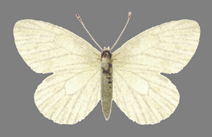
Pieris (ex Artogeia) virginiensis W.H. Edwards, 1870 [Pieridae]: in Pale Fire, commentator Kinbote is puzzled by John Shade's line "The Toothwort White haunted our woods in May". He muses, "Frankly, I am not certain what this means. My dictionary defines 'toothwort' as 'a kind of cress' and the noun 'white' as 'any pure white breed of farm animal or a certain genus of Lepidoptera'. Little help is provided by the variant written in the margin: 'In woods Virginia Whites occurred in May'. Folklore characters, perhaps? Fairies? Or cabbage butterflies?"
Neither, nor. The Toothwort White is Pieris virginiensis. It is similar to »Pieris napi, the Mustard White, but without the yellow tint on the underside of the hindwings. There is one brood only, flying for a few weeks in late April and early May. It is found very locally only in deciduous woodlands where its foodplant grows, toothwort (Dentaria diphylla and Dentaria lacinata). Its range is the Great Lakes region and the east coast from New England south to Georgia.
Cornell entomologist John G. Franclemont tells that in the early fifties he went collecting with Nabokov a few times in the vicinity of Ithaca, New York, and that Nabokov very much wanted to capture Pieris virginiensis, but did not (Achievements of VN 227). A few years later, Nabokov wrote Franclemont, "In April we stayed for a week in the Great Smokies, Tenn., where we had a delightful time with Pieris virginiensis" (May 31, 1959, in Nabokov's Butterflies, p. 528).
The name 'Toothwort White' is listed in Jacqueline Y. Miller's The Common Names of North American Butterflies (1992) as one of four names of Pieris virginiensis, but according to Robert E. Dirig and Robert Michael Pyle (personal communications), it may originally have been coined by Nabokov in Pale Fire. Brian Boyd likewise thinks so (Nabokov's Pale Fire, Princeton, New Jersey 1999, p. 276). Neither Dirig nor Pyle have found it in any other source. The common name most often used is 'West Virginia White'. Dirig: "The name 'Toothwort White' just shouts to me of Nabokov's creativity and special sensitivity, since other closely related Whites are also named for their foodplants: 'Mustard White' and 'Cabbage White'. Pieris virginiensis feeds on toothworts, so it makes full sense; and VN's razor-sharp perceptions would have picked up on the parallelism."
In Brian Boyd's reading of Pale Fire, homely and unhappy Hazel Shade is associated with the "dingy Toothwort White", while after her death her spirit is transformed into an "exuberant [»Vanessa] atalanta" (Nabokov's Pale Fire, Princeton, New Jersey 1999, p. 145).
*PaleF 44, 183–184; NabBut 528 (L)
& Ac: Píeris/Artogeía virginiénsis • Am: Toothwort White, Diffuse-veined White, West Virginia White, Virginia White, Edward's White
pirata: »Microzegris pyrothoe
Pisky: As Nabokov explained in a letter to Alfred Appel, Jr., "Pisky is another form of pixy (fairy, elf) and also means 'moth' in rural England".
*Lol 46; SelLet 41


